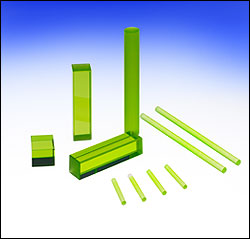
LG-930 Laser Glass
SCHOTT North America Inc.Request Info
DURYEA, Pa., Feb. 17, 2010 – Schott Advanced Optics is offering the LG-930 laser glass that lases at 1.5 µm, making it less damaging to the eye and rendering it suitable for use in biomedical applications such as skin rejuvenation, scar removal and analytical instrumentation.
 It is an erbium-/ytterbium-/chromium-doped phosphate-based laser glass used primarily in flashlamp-pumped solid-state laser systems. Phosphate glasses generally offer higher solubility of rare-earth dopants, so the number of active ions can be significantly increased.
It is an erbium-/ytterbium-/chromium-doped phosphate-based laser glass used primarily in flashlamp-pumped solid-state laser systems. Phosphate glasses generally offer higher solubility of rare-earth dopants, so the number of active ions can be significantly increased.
Advantages of the glass include good athermal properties, high transmission at the lasing wavelength, consistent quality and high homogeneity. Quality control is based on statistical process control and on rigorous final inspection of the finished component. Glass properties are measured for every melt. Measurement instruments include a variety of interferometers, spectrophotometers, physical property test systems, vision systems and a laser test bed.
This glass and the proprietary LG-x and APG-x laser glasses are typically doped with neodymium or erbium as active ions, but the company has successfully manufactured laser glasses with all rare earth ions and combinations thereof. Dopants are added to the existing base compositions of any standard laser glasses per customer specifications.
Erbium laser properties include an emission effective linewidth of 41.5 nm, an emission linewidth of 28.1 nm FWHM, fluorescence lifetime of 9 ms and loss at the lasing wavelength of 0.09 cm-1.
The lasing properties of a rod or slab are influenced by the quality of the polish and the coating. For consistency and reliability, the LG-930 is provided fully finished and dielectrically coated to customer specifications. High laser damage thresholds meet the requirements of demanding applications.
https://www.schott.com
/Buyers_Guide/SCHOTT_North_America_Inc/c16750
Published: February 2010
REQUEST INFO ABOUT THIS PRODUCT
* First Name:
* Last Name:
* Email Address:
* Company:
* Country:
Message:
When you click "Send Request", we will record and send your personal contact information to SCHOTT North America Inc. by email so they may respond directly. You also agree that Photonics Media may contact you with information related to this inquiry, and that you have read and accept our
Privacy Policy and
Terms and Conditions of Use.
Register or login to auto-populate this form:
Login
Register
* Required